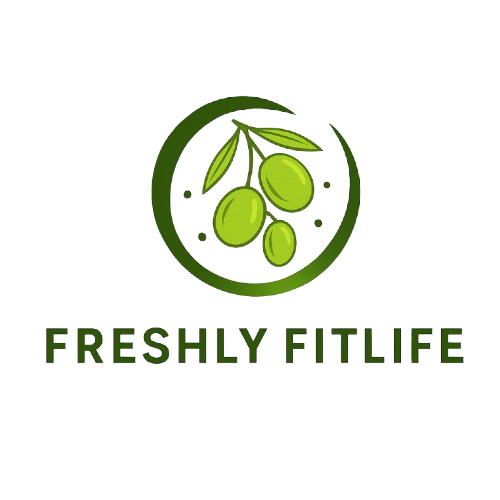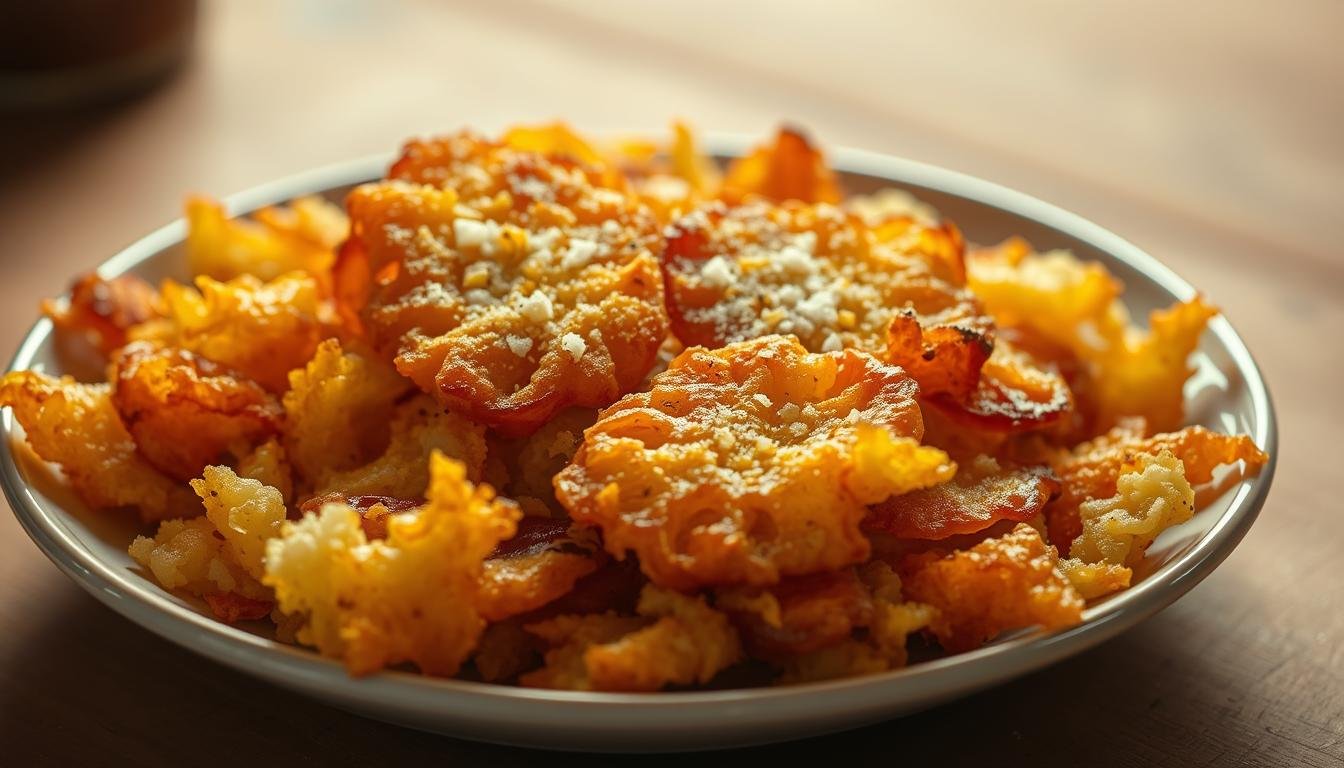Golden, crispy, and undeniably delicious—hash browns dominate breakfast plates across America. But do they belong in a balanced diet? While many enjoy them for their taste, the nutritional debate lingers.
Potatoes, the main ingredient, pack potassium and fiber. Yet, preparation methods matter. Restaurant versions often drown in oil, while homemade options can be lighter. Olive oil, for instance, adds heart-healthy fats, as shown in recent studies.
This guide explores their benefits, risks, and smarter ways to enjoy them. Whether you prefer classic or gluten-free twists, we’ll break down what makes them worth savoring—or skipping.
Key Takeaways
- Hash browns offer fiber and potassium from potatoes.
- Preparation impacts nutrition—homemade tends to be healthier.
- Olive oil can boost heart benefits when cooking.
- Dietary tweaks make them vegan or gluten-free friendly.
- Portion control helps balance indulgence and nutrition.
Are Hashbrowns Healthy? The Truth Behind This Breakfast Favorite
A staple in diners and kitchens, shredded potatoes turn golden perfection when cooked right. But their nutritional value hinges on ingredients and techniques. Let’s peel back the layers.
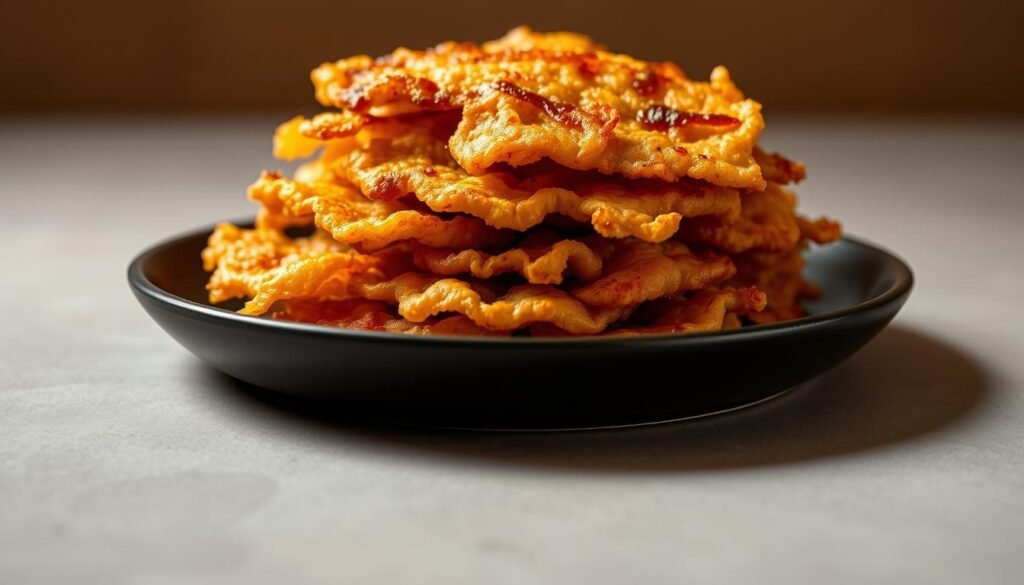
Nutritional Profile of Traditional Hashbrowns
One serving packs 26g carbs and 3g protein, with 600mg potassium—great for muscle function. Homemade versions average 180 calories, while restaurant plates often hit 300+.
Sodium varies wildly: 8mg if you skip salt vs. 300mg+ in fast-food renditions. Oil choice matters too. Monounsaturated fats (like olive oil) beat trans fats for heart health.
How Cooking Methods Impact Healthiness
Pan-frying at home absorbs less fat than deep-frying. High-heat commercial prep risks oxidation, stripping nutrients. For crispiness without guilt, air-frying cuts calories by 40%.
Pro tip: Squeeze shredded spuds dry to reduce oil absorption. Pair with veggies or eggs to balance macros.
Key Health Benefits of Homemade Hash Browns
Homemade versions shine with nutrients often lost in restaurant prep. By controlling ingredients, you boost fiber, slash sodium, and even add protein.
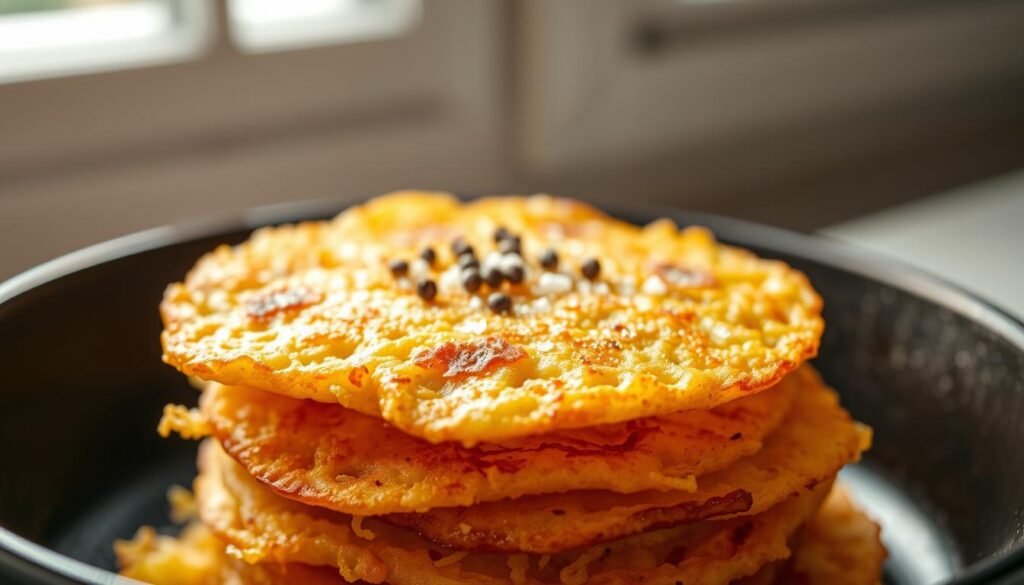
Potassium Power: Why Potatoes Are a Nutrient Booster
Russet potatoes pack 8mg vitamin C and 1,640mg potassium per serving—four times a banana’s amount. Potassium-rich potatoes help regulate blood pressure and muscle function.
- Fiber: 2g per serving (vs. 1g in frozen). Skins on double antioxidants.
- Low sodium: Homemade lets you skip excess salt common in diners.
- Vegan swaps: Flaxseed binds shreds instead of eggs.
Heart-Healthy Fats: The Olive Oil Advantage
Pan-frying in olive oil beats deep-frying. A study links its monounsaturated fats to 19% lower heart disease risk. For crispiness without guilt:
“High-heat oils like avocado work, but olive oil’s flavor and benefits win for moderate temps.”
Pair with spinach or eggs to balance carbs with protein. Your heart—and taste buds—will thank you.
Potential Health Risks of Eating Hashbrowns
While crispy and satisfying, some versions of this breakfast staple come with hidden drawbacks. Understanding these risks helps you make smarter choices without sacrificing flavor.
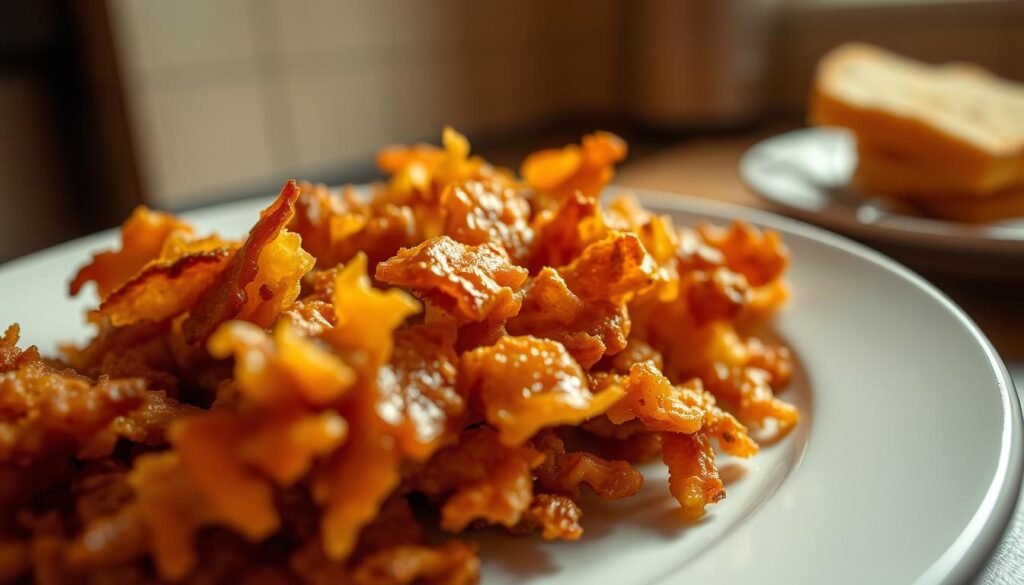
Calorie and Fat Content in Restaurant Versions
Diner-style servings often pack 300+ calories—double homemade portions. The culprit? Excessive oil absorption during deep-frying. Reused frying fat may contain trans fats, linked to heart disease.
Breadcrumb coatings add empty calories, while oversized plates encourage overeating. A study found frequent fried potato eaters faced higher health risks.
Sodium Overload: When Crispy Turns Risky
Fast-food versions can exceed 300mg salt per serving—far above the CDC’s 2,300mg daily limit. Kids’ menus often sneak in high-sodium options too.
Overcooking boosts acrylamide, a potential carcinogen. Balance is key: “Occasional indulgence is fine, but daily drives up risks,” notes a nutritionist.
- Opt for air-fried or baked to cut fat by 40%.
- Skip added salt; try garlic or paprika for flavor.
- Pair with veggies to offset heavy oil content.
Healthy vs. Unhealthy Hashbrowns: What’s the Difference?
Not all crispy potato dishes are created equal—some pack nutrients, while others hide empty calories. The gap between wholesome and greasy comes down to two factors: cooking methods and ingredients. Let’s crack the code.
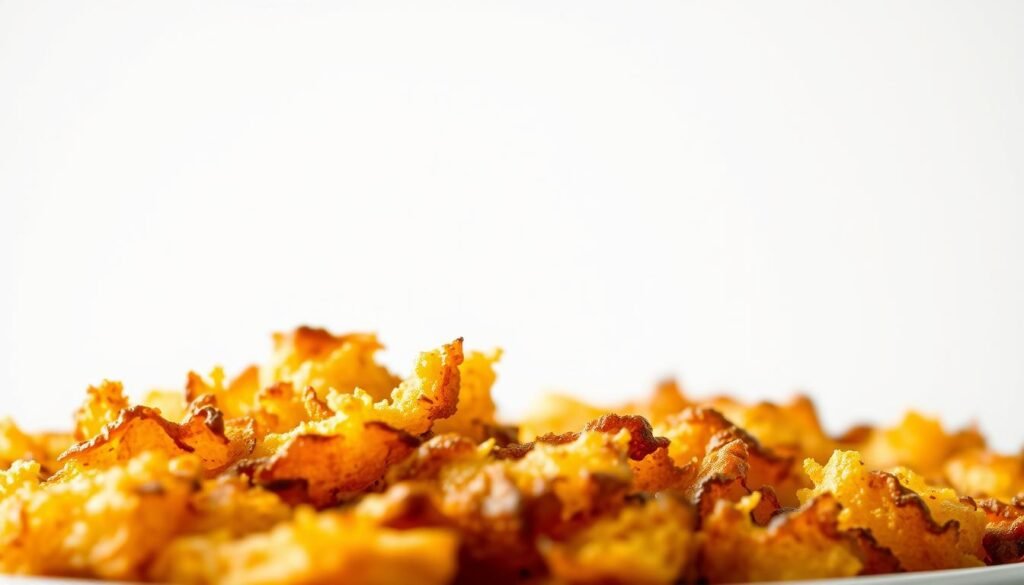
Deep-Fried vs. Air-Fried: A Calorie Showdown
Deep-frying soaks shredded potatoes in oil, adding 300+ calories per serving. An air fryer slashes that by 70%, using just a spritz of oil for the same crunch. Research shows air-frying preserves more vitamin C, too.
Pro tip: Skip commercial fryers—reused oil breeds trans fats. Home air fryer methods keep it heart-smart.
Fresh Potatoes vs. Frozen: Nutrient Face-Off
Fresh potatoes deliver peak potassium and fiber, especially with skins on. Flash-frozen versions lose 15% of vitamin C during processing. Some brands add preservatives like sodium acid pyrophosphate.
- Glycemic impact: Fresh spuds digest slower than pre-cooked frozen shreds.
- Clean swaps: Cascadian Farm’s organic line skips additives.
- Gluten-free: Spelt flour binds shreds without gluten.
“Flash-freezing locks in nutrients better than slow freezing, but fresh always wins for bioavailability.”
How to Make Healthy Hashbrowns at Home
Crispy, golden results begin long before the pan sizzles. With the right ingredients and tools, homemade versions outshine greasy diner plates. Here’s how to nail texture and flavor every time.
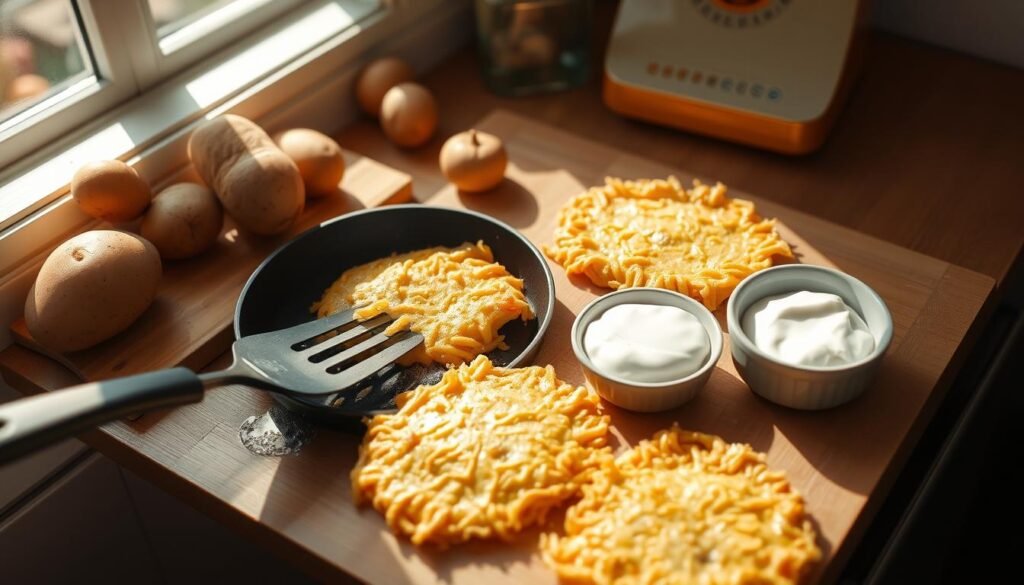
Choosing the Right Potatoes for Optimal Crispiness
Russet potatoes reign supreme for shredded potatoes. Their low moisture and high starch content ensure a crisp finish. Yukon Golds, while creamier, risk sogginess.
- Texture: Russets shred evenly; Yukons bind better for patties.
- Prep tip: Chill potatoes 30 minutes before grating to reduce stickiness.
- Skin on: Doubles fiber and antioxidants.
Essential Tools for Perfect Shredded Hash Browns
The wrong equipment turns shredded potatoes into a mushy mess. Prioritize these:
- Box grater: Creates uniform shreds (faster than a food processor).
- Cast-iron pan: Distributes heat evenly for even browning.
- Potato ricer: Efficiently removes moisture (or use cheesecloth).
“A dry potato is a crispy potato. Squeeze shreds like you’re wringing out a towel.”
For small batches, a non-stick pan works, but avoid overcrowding—½-inch layers cook best.
The Secret to Crispy Hash Browns Every Time
Achieving the perfect crunch starts with one simple rule—eliminate moisture. Potatoes release water when shredded, creating steam that ruins crispiness. Mastering this step separates limp spuds from golden perfection.
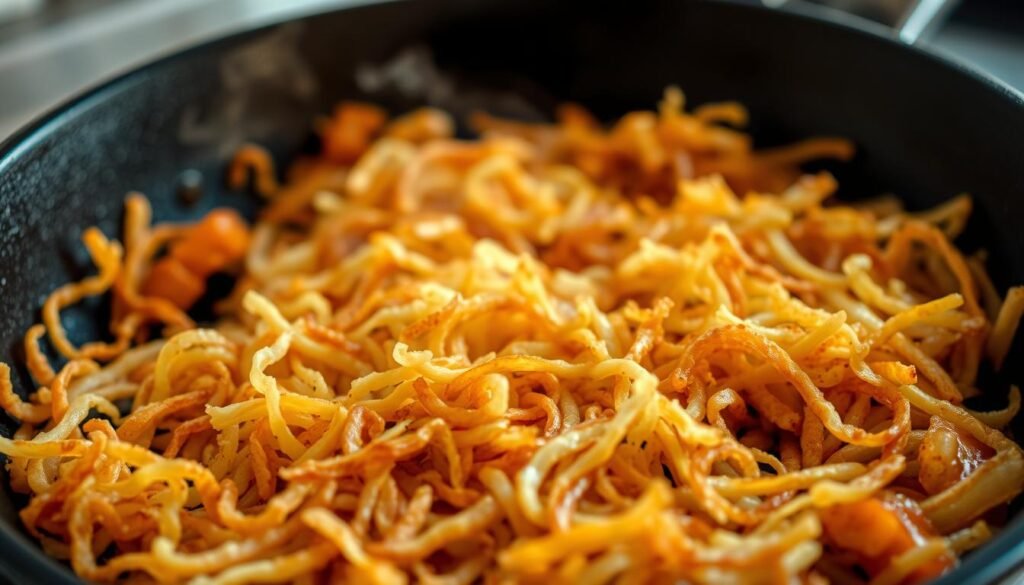
Why Moisture Removal Is Non-Negotiable
Starch activation is key. Wet shreds clump together, while dry ones crisp evenly. Squeezing triggers starch to bind, forming a crispy crust when cooked. Skip this, and you’ll get a mushy mess.
“Think of potatoes like a sponge. Wring them out thoroughly, or they’ll fry in their own steam.”
3 Proven Methods to Squeeze Out Excess Water
- Tea towel twist: Wrap shreds and twist tightly. Fast but messy.
- Potato ricer: Presses liquid out efficiently—ideal for large batches.
- Paper towel press: Layer shreds between towels; absorbs water quickly.
| Method | Speed | Efficiency | Best For |
|---|---|---|---|
| Tea Towel | Fast | Medium | Small batches |
| Potato Ricer | Slow | High | Large quantities |
| Paper Towel | Medium | Low | Quick fixes |
Cook immediately after squeezing. Letting shreds sit reabsorbs moisture, undoing your hard work. For peak crispiness, keep time between prep and pan under 10 minutes.
Step-by-Step Guide to Golden Brown Hashbrowns
Golden brown results aren’t accidental; they’re a science of controlled heat and strategic flipping. Follow these steps to elevate shredded potatoes from bland to brilliant.
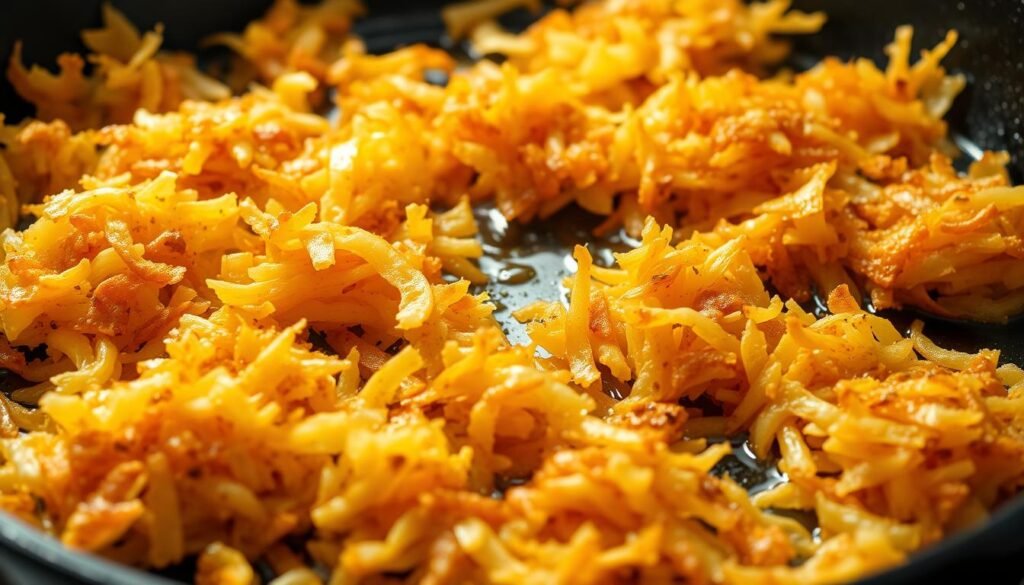
Prepping Your Pan: Oil and Heat Essentials
Start with a heavy pan—cast iron distributes heat evenly. Medium heat (350°F) prevents burning while ensuring crispiness. Too hot, and they’ll char; too low, and they’ll steam.
- Oil smoke points: Avocado oil (520°F) for high heat, olive oil (375°F) for moderate temps.
- ½-inch thickness: Spread shreds evenly for uniform cooking.
- Visual cues: Edges turn amber in 3–4 minutes—your signal to flip.
| Oil Type | Smoke Point | Best For |
|---|---|---|
| Avocado | 520°F | High-heat searing |
| Olive | 375°F | Medium-heat browning |
| Coconut | 350°F | Low-heat recipes |
Timing Is Everything: When to Flip for Perfect Browning
Wait for the crust to form—about 3 minutes. Slide two spatulas underneath for support, then flip in one confident motion. Patience pays off here.
“Resist pressing shreds down. Let them cook undisturbed to build that crispy lattice.”
- Heat recovery: The pan temp drops after flipping. Give it 30 seconds to rebound.
- Batch management: Keep finished hashbrowns in a single layer on a wire rack (not stacked).
- Oven hack: Warm at 200°F if cooking multiple batches.
Golden brown perfection hinges on time and technique. Now, grab your spatula—it’s crunch time.
Healthy Oil Choices for Cooking Hash Browns
Not all cooking oils are created equal when it comes to perfecting crispy hash browns. The right oil affects crispiness, nutritional value, and even potential health risks. Let’s break down the best options for golden results without compromising wellness.
Olive Oil vs. Avocado Oil: Smoke Points Compared
Smoke point—the temperature when oil starts burning—determines cooking safety. Avocado oil leads with a 520°F smoke point, ideal for high-heat methods. Extra virgin olive oil (375°F) works better for moderate pan-frying.
- Cost factor: Avocado oil costs 3x more per tablespoon than light olive oil
- Flavor carryover: Olive oil adds subtle fruitiness; avocado stays neutral
- Health edge: Both contain heart-healthy monounsaturated fat
| Oil Type | Smoke Point | Best Use | Price/Tbsp |
|---|---|---|---|
| Avocado | 520°F | Deep-frying | $0.75 |
| Light Olive | 465°F | Pan-frying | $0.25 |
| Extra Virgin Olive | 375°F | Low-heat sauté | $0.30 |
Why Lard and Butter Fall Short
While traditional fats like butter add rich flavor, their drawbacks outweigh benefits. Butter’s saturated fat content (7g/tbsp) impacts cholesterol, while lard contains 95mg cholesterol per serving.
“For occasional indulgence, clarified butter (ghee) works—its smoke point hits 485°F. But daily use? Stick to plant-based oils.”
High-oleic sunflower oil offers a smart compromise with 450°F stability and neutral taste. As research shows, switching to unsaturated fats supports long-term heart health.
For air fryer users, just ¼ teaspoon of avocado oil achieves crispiness equivalent to deep-frying. Smart choices mean enjoying golden hash browns without guilt—just pure crunch.
Creative Twists on Classic Hash Brown Recipes
Transform your morning routine with these inventive takes on a breakfast classic. Swap traditional spuds for vibrant alternatives packed with nutrients—no compromise on crunch.
Sweet Potato Hash Browns: A Vitamin A Upgrade
Orange-fleshed sweet potatoes deliver 400% of your daily vitamin A per serving. Their natural sweetness caramelizes beautifully, adding depth to every bite.
- Beta-carotene boost: 1 cup shredded sweet potatoes = 14mg vs. russets’ 0mg.
- Moisture trick: Toss shreds with 1 tsp cornstarch to prevent sogginess.
- Spiralized mixes: Combine with carrots or beets for color contrast.
| Nutrient | Sweet Potato (1 cup) | Russet Potato (1 cup) |
|---|---|---|
| Vitamin A | 1,100 mcg | 0 mcg |
| Fiber | 4g | 2g |
| Glycemic Index | 54 | 78 |
Vegan Hash Brown Patties With Zucchini and Onions
Flax eggs bind shredded zucchini and onions into crispy patties—dairy-free and gluten-friendly. The zucchini adds moisture, while onions lend a savory punch.
“Chickpea flour adds 5g protein per patty, making these a powerhouse for plant-based diets.”
- Flax egg sub: 1 tbsp ground flax + 3 tbsp water = 1 egg.
- Meal prep: Freeze uncooked patties between parchment paper.
- Breakfast tacos: Crumble patties into tortillas with avocado.
For more ideas, try cauliflower rice or parsnip shreds. A sprinkle of smoked paprika ties all the ingredients together.
Protein-Powered Hashbrown Pairings
Boost your morning meal with smart pairings that turn simple spuds into protein-packed fuel. Balancing carbs with protein keeps energy steady and cravings at bay. Here’s how to elevate your breakfast game.
Egg Combos for Balanced Breakfasts
Poached or scrambled, egg additions add 6g protein per serving. Try these winning duos:
- Post-workout boost: Top hash browns with a fried egg and avocado (12g protein total).
- Greek yogurt hack: Swap sour cream for yogurt—adds 10g protein per ½ cup.
- Tofu scramble: A vegan twist with 8g protein per ¾ cup serving.
“Pairing eggs with potatoes creates a complete amino acid profile. It’s a muscle-recovery powerhouse.”
Lean Meats for Extra Staying Power
Incorporate these high-protein side options for a hearty plate:
| Protein Source | Protein (per oz) | Calories |
|---|---|---|
| Turkey sausage crumbles | 7g | 50 |
| Smoked salmon | 5g | 55 |
| Grilled chicken strips | 9g | 48 |
Portion control matters: Aim for 2–3 oz of meat per breakfast. Combine with veggies for fiber and micronutrients.
Common Hashbrown Mistakes and How to Fix Them
Small missteps can turn golden shreds into a disappointing, soggy mess. Whether you’re a beginner or a breakfast pro, these troubleshooting tips save your spuds from common pitfalls.
Why Your Hashbrowns Stick (and How to Prevent It)
A sticky pan ruins texture and makes flipping impossible. These method adjustments guarantee release:
- Season maintenance: Rub cast iron with oil after each use. Carbon buildup causes sticking.
- Cold oil test: Sprinkle water droplets in the pan—if they sizzle, it’s ready.
- Thermal shock prevention: Avoid overcrowding. Adding shreds lowers the heat too quickly.
“Non-stick surfaces work, but a well-seasoned cast iron delivers superior browning without chemical coatings.”
Thickness Matters: The ½-Inch Golden Rule
Too thin, and shreds burn; too thick, and steam traps moisture. Measure with these tricks:
- Grate size: Large holes create air pockets for crispiness. Fine shreds mat together.
- ¼ cup portions: This measured amount spreads perfectly in standard pans.
- Press lightly: Compact just enough to hold shape—overworking makes them dense.
| Thickness | Result | Fix |
|---|---|---|
| Under ¼” | Burnt edges | Lower heat by 25°F |
| ½” ideal | Even browning | Maintain medium heat |
| Over ¾” | Soggy center | Flip twice, add 2 mins cook time |
For emergency salvage, slide a spatula under stuck shreds and drizzle 1 tsp oil around edges. The extra fat often releases them intact.
Conclusion: Enjoying Hashbrowns the Healthy Way
With smart prep and mindful choices, crispy spuds can fit into a balanced diet. Homemade hash delivers potassium and fiber, especially when cooked in heart-smart oils like avocado or olive.
Keep portions modest—aim for ½-cup servings twice weekly. Rotate with veggie-based sides or lean proteins for variety. Farmers’ market potatoes boost freshness, while dietitian consultations tailor plans.
Ready to try? Whip up a batch using our air-fryer method. Share your healthy hash creations online—tag #CrispySmartEats!
